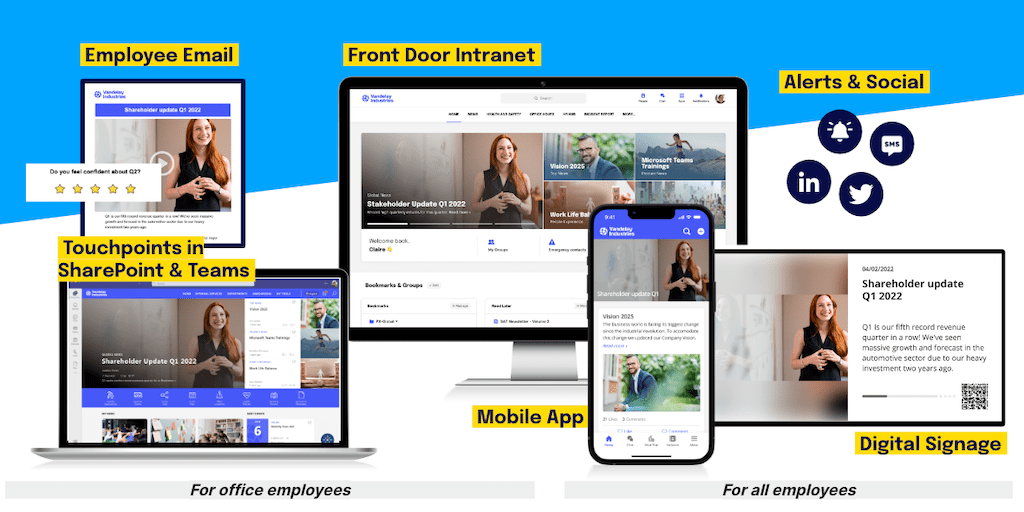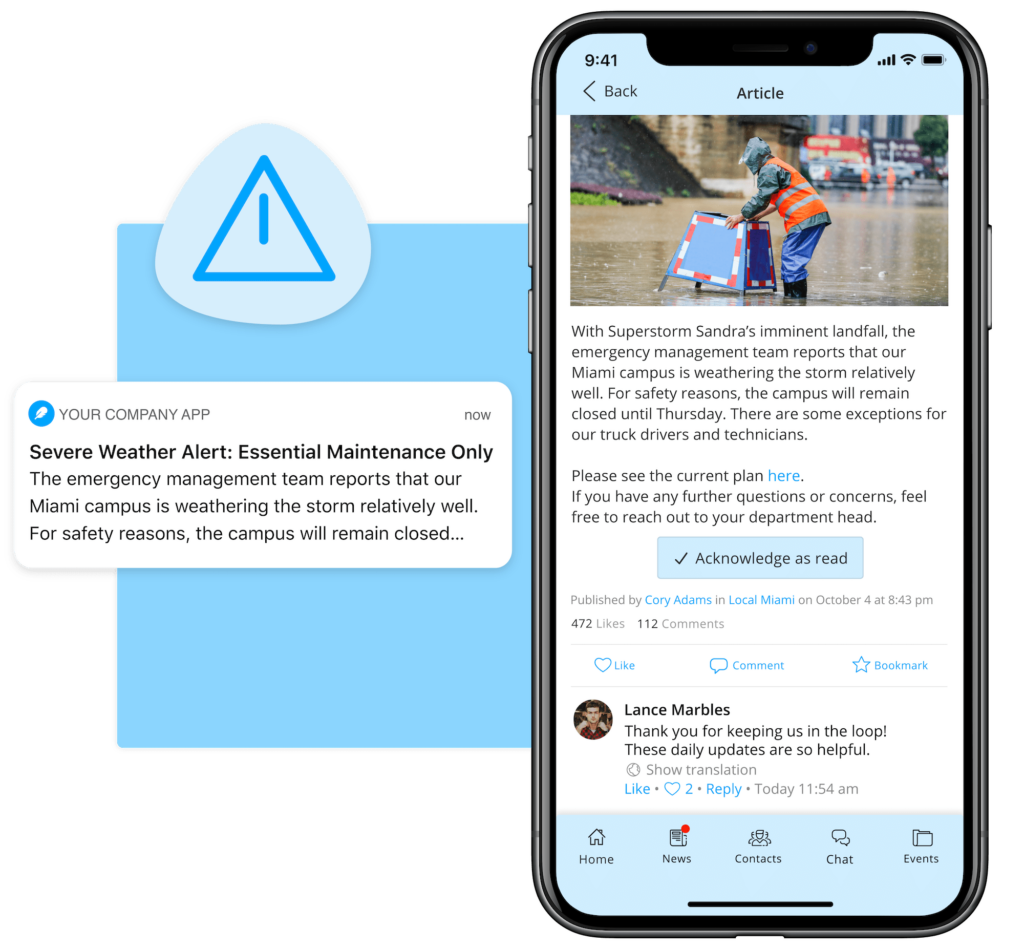We've heard from organizations time and again that their greatest desire is to better engage their people. And today's workforce wants to do engaging work. So what's the problem? Let's dive into the benefits of employee engagement, find out why they're such a struggle to achieve, and see what can be done.
What is Employee Engagement?
Simply put, employee engagement is the emotional commitment and investment that employees have towards their work, their organization, and its goals. Engaged employees are self-motivated, show enthusiasm, and feel inspired to go above and beyond in order to contribute to the success of their company. Employee engagement strategies that foster a culture of engagement allow organizations to unlock the full scope of employee engagement benefits to effectively achieve their business objectives.
Employee engagement is about motivating people to give their best at work, fostering enthusiasm, and inspiring them to contribute positively to the company's success. This emotional commitment leads to a wealth of employee engagement benefits. These include higher productivity, innovation, job satisfaction, and ultimately, full organizational success.
Why is Employee Engagement so important?
Employee engagement yields a ton of benefits across every aspect of an organization.
Firstly, engaged employees are more productive by virtue of being more focused, motivated, and committed to their work. This results in increased efficiency and task accomplishment. Secondly, they contribute to improved performance outcomes by going the extra mile in their roles, leading to enhanced organizational success. Additionally, employee engagement fosters greater job satisfaction among employees. They feel more valued, appreciated, and fulfilled by their work, ultimately boosting morale and overall satisfaction.
Moreover, organizations with high levels of employee engagement benefit from reduced turnover rates. They save on recruitment and training costs while maintaining a stable workforce. Engaged employees also drive innovation within the organization. They contribute innovative ideas, problem-solving approaches, and creative solutions, contributing to a culture of innovation. Furthermore, their dedication to delivering excellent customer service enhances customer satisfaction, leading to positive relationships with clients and customers.
Lastly, employee engagement contributes to the development of a strong and positive organizational culture. Engaged employees act as brand ambassadors, embodying the organization's values, mission, and goals. Studies have shown that organizations with high levels of employee engagement are more profitable. Engaged employees drive revenue growth through their increased productivity, performance, and customer satisfaction.
As for disengagement, it's costly.

New McKinsey research reveals that employee disengagement and attrition could cost a median-size S&P 500 company between $228 million and $355 million a year in lost productivity. That adds up to at least $1.1 billion in lost value per company over five years.
So, how else does employee engagement contribute to the bottom line? Let us count the ways.
20 benefits of Employee Engagement
- Greater Productivity: Engaged employees are more focused, motivated, and committed to their work, leading to higher levels of productivity and efficiency. They’re willing to invest discretionary effort to accomplish tasks and achieve organizational goals.
- Improved Performance: Engaged employees generally perform better in their roles and contribute more effectively to the success of their organization. They are more likely to go the extra mile, resulting in improved performance outcomes.
- Enhanced Employee Satisfaction: Engaged employees are more satisfied with their jobs and their organization as a whole. They feel valued, appreciated, and fulfilled by their work, leading to higher levels of job satisfaction and morale.
- Reduced Turnover: Organizations with high levels of employee engagement typically experience lower turnover rates. Engaged employees are more likely to stay with a company, reducing the recruitment and training costs associated with turnover.
- Increased Innovation and Creativity: Engaged employees are more likely to contribute innovative ideas, problem-solving approaches, and creative solutions. They feel empowered to share their perspectives and take risks, fostering a culture of innovation within the organization.
- Better Customer Satisfaction: Engaged employees deliver excellent customer service and build positive relationships with clients and customers. Their enthusiasm and commitment translate into better customer experiences and higher levels of satisfaction.
- Stronger Organizational Culture: Employee engagement contributes to the development of a strong and positive organizational culture. Engaged employees act as brand ambassadors, embodying their organization's values, mission, and goals.
- Increased Profitability: Studies have shown that organizations with high levels of employee engagement are more profitable. Engaged employees drive revenue growth through increased productivity, performance, and customer satisfaction.
- Improved Employee Health: Engaged employees often experience lower levels of stress and better physical and mental health.
- Increased Employee Loyalty: Engaged employees are more loyal to their organizations, leading to longer tenures and stronger relationships.
- Faster Problem Solving: Engaged employees are more likely to collaborate and communicate effectively, leading to quicker problem-solving.
- Enhanced Teamwork: Engaged employees work better together, fostering a more collaborative and supportive work environment.
- Greater Employee Empowerment: Engaged employees feel empowered to take ownership of their work and contribute to the organization's success.
- Reduced Absenteeism: Engaged employees are more likely to show up for work consistently, reducing absenteeism rates.
- Better Work-Life Balance: Engaged employees often have a better balance between their work and personal lives, leading to higher job satisfaction.
- Increased Employee Motivation: Engaged employees are intrinsically motivated to perform well and achieve their goals.
- Enhanced Employee Development: Engaged employees are more likely to seek out and participate in opportunities for learning and development.
- Improved Employee Retention: Engaged employees are more likely to stay with their organizations for the long term, reducing turnover.
- Positive Employer Branding: Engaged employees are great ambassadors for their organizations, contributing to a positive employer brand.
- Better Financial Performance: Engaged employees can lead to improved financial performance through their increased productivity, customer satisfaction, and innovation.
How to improve employee engagement
Improving employee engagement requires an approach that addresses various aspects of your organization's culture and practices.
Firstly, having effective communication channels is essential for building trust and transparency. Doing so keeps employees informed about company goals, changes, and developments. Encouraging feedback and suggestions, and actively listening to employees' concerns and ideas, further promotes engagement.
Additionally, implementing recognition programs to acknowledge and appreciate employees' contributions and achievements boosts morale and motivation. Providing opportunities for growth through training, learning, and career development programs demonstrates a commitment to employees' long-term success. It also fosters a sense of investment in their professional growth. Promoting work-life balance by offering flexible working hours and supporting employee wellbeing through wellness programs and resources also plays a vital role in enhancing engagement.
Furthermore, empowering employees by giving them autonomy and ownership over their work reinforces positive behaviors and strengthens engagement. So to do regular feedback sessions and performance reviews.
And finally, leading by example, demonstrating a strong work ethic, effective communication skills, and a commitment to the organization's values, is crucial for inspiring and motivating employees to actively participate and collaborate, ultimately improving overall engagement levels.
The vital role of internal communications in building employee engagement
Internal communications play a leading role in creating employee engagement. Effective internal communication serves as the backbone of an engaged workforce by facilitating transparency, trust, and alignment within an organization. By keeping employees informed about company updates, goals, and changes, internal communications foster a sense of connection and understanding of their contributions to organizational objectives.
Moreover, open and transparent communication cultivates trust between employees and management, making employees feel valued and heard. This trust is essential for creating a positive environment where employees feel comfortable expressing their ideas, concerns, and feedback.
Additionally, internal communication channels provide opportunities for recognition, feedback, and two-way dialogue. They reinforce positive behaviors and addresses employee needs and preferences. During times of change, effective internal communication manages uncertainty and promotes support for organizational initiatives, ensuring employees remain engaged and motivated.
In general, internal communications play a crucial role in creating a culture of engagement, collaboration, and productivity within the organization.
How an internal comms platform can boost employee engagement
An internal communications platform can significantly boost employee engagement by providing efficient, streamlined, and interactive communication channels within the organization.
- Centralized, Multichannel Communication Hub: An internal communications platform serves as a centralized location where employees can access important information, announcements, updates, and company resources in one place. This ensures that employees stay informed and connected regardless of their location or department, fostering a sense of belonging and inclusion.

- Real-Time Communication: Internal communications platforms enable real-time communication through features such as instant messaging and push notifications. This facilitates quick and efficient communication between employees, teams, and departments, allowing for seamless collaboration and decision-making.
- Accessibility and Convenience: Internal communications platforms are accessible from various devices, including desktop computers, laptops, smartphones, and tablets. This accessibility ensures that employees can stay connected and engaged whether they're in the office, working remotely, or on the go.
- Two-Way Communication: Many internal communications platforms support two-way communication, allowing employees to provide feedback, ask questions, and share ideas with management and colleagues. This fosters a culture of open dialogue, transparency, and employee empowerment, leading to higher levels of engagement and morale.
- Personalization and Targeted Messaging: Internal communications platforms enable organizations to personalize communication and target specific messages to relevant groups or individuals. By delivering tailored content based on employees' roles, interests, and preferences, organizations can increase the relevance and impact of their communication, enhancing engagement and responsiveness.

- Employee Recognition and Feedback: Internal communications platforms often include features for employee recognition, such as peer-to-peer recognition, likes, and employee-generated news feeds. These features enable employees to acknowledge and celebrate each other's achievements, fostering a culture of appreciation and recognition that boosts morale and engagement. Additionally, built-in feedback mechanisms allow employees to provide input on various initiatives, policies, and organizational matters, making them feel valued and heard.
- Training and Development Opportunities: Internal communications platforms can be used to deliver training modules, e-learning courses, and professional development resources to employees. By providing access to continuous learning opportunities, organizations demonstrate their commitment to employee growth and development, leading to increased engagement and retention.
- Surveys and Polls: Internal communications platforms often include survey and polling tools that enable organizations to gather feedback, measure employee sentiment, and assess engagement levels. By regularly soliciting input from employees and acting upon their feedback, organizations can demonstrate their commitment to continuous improvement and employee satisfaction, strengthening engagement and loyalty.

Overall, an internal communications platform serves as a powerful generator of employee engagement benefits. It facilitates seamless communication, fostering collaboration, promoting transparency, and empowering employees to contribute to the success of their organization. By investing in the right internal communication tools and strategies, companies can create a more engaged, motivated, and connected workforce. These powerful benefits will be reflected in enhanced productivity, innovation, and overall success.




